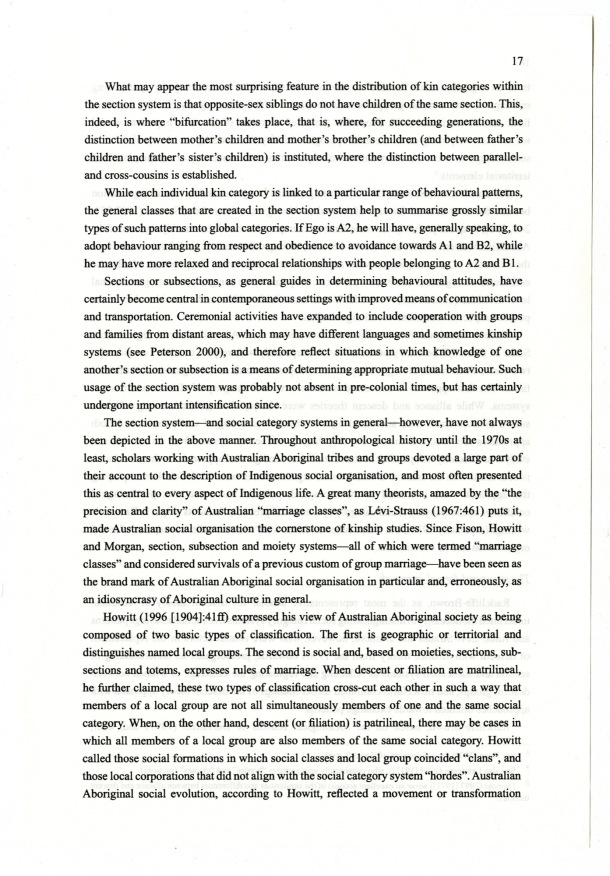|
| 
[Note: this transcription was produced by an automatic OCR engine]
17
What may appear the most surprising feature in the distribution of kin categories within
the section system is that opposite-sex siblings do not have children of the same section. This,
indeed, is where “bifurcation" takes place, that is, where, for succeeding generations, the
distinction between mother’s children and mother’s brother’s children and between father’s
children and father’s sister’s children is instituted, where the distinction between parallel-
and cross-cousins is established.
While each individual kin category is linked to a particular range of behavioural patterns,
the general classes that are created in the section system help to summarise grossly similar
types of such patterns into global categories. If Ego is A2, he will have, generally speaking, to
adopt behaviour ranging flom respect and obedience to avoidance towards A1 and B2, while
he may have more relaxed and reciprocal relationships with people belonging to A2 and B 1.
Sections or subsections, as general guides in determining behavioural attitudes, have
certainly become central in contemporaneous settings with improved means of communication
and transportation. Ceremonial activities have expanded to include cooperation with groups
and families from distant areas, which may have different languages and sometimes kinship
systems see Peterson 2000, and therefore reflect situations in which knowledge of one
another’s section or subsection is a means of determ.i.n.i.ng appropriate mutual behaviour. Such
usage of the section system was probably not absent in pre-colonial times, but has certainly
undergone important intensification since.
The section systen1~and social category systems in general—however, have not always
been depicted in the above manner. Throughout anthropological history until the 1970s at
least, scholars working with Australian Aboriginal tribes and groups devoted a large part of
their account to the description of Indigenous social organisation, and most often presented
this as central to every aspect of Indigenous life. A great many theorists, amazed by the “the
precision and clarity” of Australian “marriage classes”, as Lévi-Strauss 1967:46l puts it,
made Australian social organisation the cornerstone of kinship studies. Since Fison, Howitt
and Morgan, section, subsection and moiety systems—all of which were termed “marriage
classes" and considered survivals of a previous custom of group marriage—have been seen as
the brand mark of Australian Aboriginal social organisation in particular and, erroneously, as
an idiosyncrasy of Aboriginal culture in general.
Howitt 1996 [l904]:4lfi expressed his View of Australian Aboriginal society as being
composed of two basic types of classification. The first is geographic or territorial and
distinguishes named local groups. The second is social and, based on moieties, sections, sub-
sections and totems, expresses rules of marriage. When descent or filiation are matrilineal,
he further claimed, these two types of classification cross-cut each other in such a way that
members of a local group are not all simultaneously members of one and the same social
category. When, on the other hand, descent or filiation is patrilineal, there may be cases in
which all members of a local group are also members of the same social category. Howitt
called those social fonnations in which social classes and local group coincided “clans”, and
those local corporations that did not align with the social category system “hordes”. Australian
Aboriginal social evolution, according to Howitt, reflected a movement or transformation
|